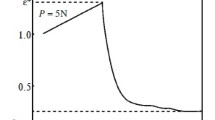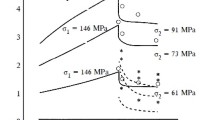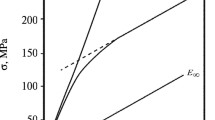Methods of mathematical modeling, computer prediction, and systems analysis of functional properties of synthetic textile materials are reviewed. The developed models and methods are used to describe the functional properties and prediction of workwear deformation processes.
Similar content being viewed by others
Explore related subjects
Discover the latest articles, news and stories from top researchers in related subjects.Avoid common mistakes on your manuscript.
A great variety of micro- and macro-structured textile materials are used in textile and light industries. They can be tentatively divided in terms of type of structure of textile materials into two groups.
The first group consists of materials having a simple macrostructure, i.e., various types of synthetic fibers. The second group includes materials having a more complex macrostructure comprised precisely of a combination of simple components. This group includes all kinds of fabrics, tapes, braids, yarns, tows, artificial leathers, etc.
Active methods of investigation of physicomechanical properties of polymers began in the mid-twentieth century. These investigations are founded on experiment-based phenomenological theories.
One of the developed directions is based on the concept of activating nature of mechanical impacts at the point of action of nondestructive loads and deformations. The mathematical models describing relaxation are based on inclusion of relaxation time [1] and, consequently, of delay time for describing creep.
At present, the first group of materials, for which mathematical models that satisfactorily describe their physicomechanical properties were constructed, is studied most.
For example, we may choose in this case a model based on the assumption that the relaxing particles are distributed in a normal fashion in terms of intrinsic relaxation and delay times. This model, as some others, makes it possible to calculate from the experimental “families“ of relaxation and creep curves the main physicomechanical characteristics of synthetic materials belonging primarily to the first group [2].
However, as experimental check showed, the accuracy of determination of physicomechanical characteristics decreases when these methods are used for the second group of materials. This fact, just as the fact that the second group of materials, which are more widespread than the first group, is studied less, created the ground for finding new mathematical models of viscoelastic properties that take account of the complex macrostructure of the studied objects.
The main problem that needs to be solved for designing devices for personal protection from mechanical impacts consists in determination of the scores of evaluation of the physicomechanical properties of impact-resistive paddings and their quantitative values that are adequate for injury risk criteria.
Experiments showed that the mathematical model of viscoelastic properties of materials having a complex macrostructure should be constructed with due regard for the wide diversity of distributions of particles forming the material of monofilaments based on intrinsic relaxation and delay times [3].
Such a distribution, on the one hand, must be close to normal and, on the other, must have a delayed convergence of the distribution function to its asymptotic values, which corresponds to a broadened relaxation spectrum. As distribution of this type, it is preferable to select distribution based on the function of normalized arc tangent of logarithm (NAL) of reduced time [4]:
where t is the current time, t1 is the base time, and 1/bp is the structural parameter.
A distinctive feature of this distribution is affiliation of the NAL function to the class of elementary functions, which considerably simplifies integrodifferential transformations.
The methods of determination of viscoelastic properties and subsequent prediction of viscoelastic processes based on use of NAL function as applied to such textile materials having a complex macrostructure as yarn, fabrics, tapes, drapes, tows, etc., as evident from checking, yield results close to experimental.
Let us consider use of the mathematical model with NAL function [5]:
where t is the time, 1/bpε is the parameter of relaxation process intensity, 1/bpσ is the parameter of creep process intensity, τε is the relaxation time, τσ is the delay time, Eεt = σ/ε is the relaxing module, E0 is the modulus of elasticity, E∞ is the modulus of viscoelasticity, Dσt = ε/σ is the compliance, D0 is the initial compliance, D∞ is the ultimate equilibrium compliance, ε is the deformation, σ is the stress for determining the viscoelastic properties of technical-purpose materials.
Values of Components of Deformation and Mechanical Work of Deformation | |||||
εt, % | εt0, % | εt − εt0, % | at, GPa | at0, GPa | att, GPa |
2 | 1,43 | 0,57 | 0,91 | 0,56 | 0,35 |
4 | 2,23 | 1,73 | 2,63 | 1,38 | 1,25 |
6 | 2,91 | 3,09 | 5,47 | 2,43 | 3,04 |
The sample chosen was cloak (raincoat) fabric based on polyester fiber with water-repelling finish from the Department of Garment Design and Technology. This fabric is used as the material of the upper part of shock-resistant helmet liner intended for protection of head from impact of accidentally falling objects.
The “families” of relaxation and creep curves of cloak fabric were obtained experimentally on a stress relaxometer by a quick method using mathematical models (2) and (3).
As a result of processing, the following physicomechanical characteristics of cloak fabric were obtained: E0 = 5.93 GPa, E∞ = 0.82 GPa, 1/bpε = 0.043, D0 = 0.17 GPa-1, D∞ = 1.22 GPa-1, 1/bpσ = 0.139, relaxation time τε (Fig. 1), and delay time τσ (Fig. 2).
The physicomechanical characteristics are used further for predicting complex deformation processes. The prediction is made as a solution of equations of nonlinear viscoelasticity:
where the integral kernels \( {\varphi}_{\upvarepsilon \mathrm{s}}^{\prime } \) and \( {\varphi}_{\upsigma \mathrm{s}}^{\prime } \) are derivatives of the NAL function (1) [6].
The efficiency of the methods of prediction of deformation processes was checked by calculation of the stretching process with a constant rate of deformation and by comparing with the experimental diagram obtained on an Instron-1122 tensile tester.
The stretching was done at the base of a 200 mm sample at the rate of 100 m/sec, which corresponds to the rate of change of deformation \( \dot{\upvarepsilon} \) =0.00083 c-1 (Fig. 3).
Predictions of more complex deformation-relaxation processes and reverse relaxation processes are made analogously using equations (4) and (5).
The calculated tensile-test diagram was used to determine the elastic component of deformation by the equation [7]:
or
For a fixed point of the tensile-test diagram with coordinates εt and σt the specific mechanical work (per unit volume) is calculated by the equation
Let us breakdown the specific mechanical work into the potential (elastic) component [8] ato = 0.5 and dispersing part att = at − at0. The results of calculation of the specific mechanical work att, its elastic component ato, dispersing components att, and the elastic component of deformation of cloak fabric are given in the table below.
As evident from the table, if the elastic component of deformation and mechanical work dominate at the initial stage of deformation, then the dispersing components characterizing the viscoelastic and plastic components of deformation begin to dominate with increase of deformation.
Modeling of viscoelastic properties gained further impetus in the form of computer methods [9], which made it possible to automate computation process. This not merely improves the accuracy of computations, i.e., of prediction, but also simplifies the process of selection of the best normalized function for the foundation of the mathematical model out of the proposed ones, i.e., from the magnitude of deviations of the calculated points from the experimental [10].
The study was financed within the ambit of the assignment of the Russian Presidential Grant No. MK-1210.2020.8 and the Russian Presidential Stipend No. SP-3895.2021.5 TO offered to young scientists and postgraduates.
References
A. A. Askadskii, Structure and Properties of Heat-resistant Polymers [in Russian], Khimiya, Moscow (2001), p. 320.
A. M. Stalevich, Probl. Prochnosti, No. 12, 95-98 (1981).
A. M. Stalevich, Mech. of Solids, 43, No. 6, 892-901 (2008).
A. M. Stalevich, Fiziko-khim. Polimerorv: Sintez, Sv-va i Primenenie., No. 8, 57-62 (2002).
A. A. Romanova, P. P. Rymkevich, et al., Izv. Vuz., Tekhnol. Tekst. Prom., No. 4 (299), 3-5 (2007).
V. Yu. Mishakov, G. Ya. Slutsker, and M. Stalevich, Fibre Chem., 38, No. 2, 158-163 (2006).
A. M. Stalevich, E. V. Kikets, et al., Fibre Chem., 35, No. 2, 164-167 (2003).
A. S. Gorshkov, A. G. Makarov, et al., Mag. Civil Eng., 44, No. 9, 76-83 and 103-104 (2013), https://doi.org/10.5862/MCE.44.10
A. M. Stalevich and A. G. Makarov, Izv. Vuz., Tekhnol. Tekst. Prom., 267, No. 3, 10-13 (2002). eid=2-s2.0-0038128574
A. M. Stalevich, A. G. Makarov, and E. D. Saidov, Izv. Vuz., Tekhnol. Tekst. Prom., 268, No. 4-5, 15-18 (2002). eid=2-s2.0-0037742684
Author information
Authors and Affiliations
Corresponding author
Additional information
Translated from Khimicheskie Volokna, No. 3, pp. 11-14, May-June 2021
Rights and permissions
About this article
Cite this article
Egorova, M.A., Egorov, I.M. & Kozlov, A.A. Computer Prediction and Analysis of Functional Properties of Synthetic Textile Materials. Fibre Chem 53, 159–162 (2021). https://doi.org/10.1007/s10692-021-10258-2
Published:
Issue Date:
DOI: https://doi.org/10.1007/s10692-021-10258-2







